Résumés Année 2013
"From Sequential to One-Pot Synthesis of Dipyrrin Based Grid-Type Mixed Metal-Organic Frameworks"
Antoine Béziau, Stéphane A. Baudron, Audrey Fluck and Mir Wais Hosseini, Inorg. Chem., 2013, 52, 14439-14448. (download .pdf)
Abstract: Both sequential and one-pot strategies for the preparation of a series of grid-type mixed metal-organic frameworks (MM’MOFs) based on dipyrrin ligands appended with either a pyridyl or a phenyl-imidazolyl moiety have been investigated. For the stepwise approach, the differentiation between the two coordination sites (nature, charge and denticity) was exploited for the synthesis of a family of five discrete Zn(II), Cu(II) and Pd(II) complexes. Acting as metallatectons, these construction building blocks lead to the formation of a series of MM’MOFs upon self-assembly with CdCl2. In these rhombic grid-type architectures, four consecutive metallatectons are bridged by Cd(II) cations adopting an octahedral coordination geometry with the chloride anions occupying apical positions thus behaving as square nodes. The shape of the rhombus grids as well as the way they are packed (stacking or interpenetration) in the crystalline phase are controlled by the nature of metallatectons and the solvent molecules present in the crystals. Consequently, the heterometallic assemblies display different accessible voids, although they are built on layers with the same connectivity. More interestingly, as demonstrated by X-Ray diffraction on both single-crystals and microcrystalline powders, the same MM’MOFs were obtained by a one-pot strategy through direct combinations of dipyrrin derivatives with the corresponding metal salts. This one-pot approach is efficient and more convenient than the sequential alternative, since the isolation, purification and characterization of the, sometimes insoluble, metallatectons are not required.
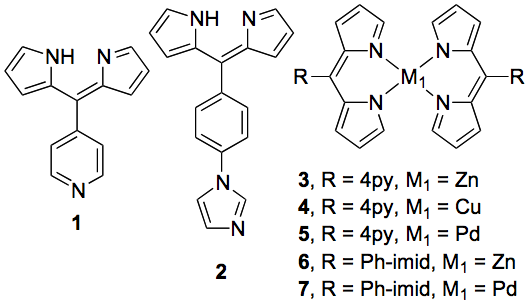 |  |  |
"Molecular tectonics: from crystals to crystals of crystals"
G. Marinescu, S. Ferlay, N. Kyritsakas and M. W. Hosseini, Chem. Commun., 2013, 11209-11211. (download .pdf)
Abstract: The in situ combination of MII cations (Co, Ni, Cu or Zn) with 2,4,6-pyridinetricarboxylic acid as ligand, a bisamidinium dication as a H-bond donor tecton and NaOH leads to the formation anionic metal complexes ML22- and their interconnection into isomorphous 3D H-bonded networks displaying different colours which were used as preformed seed crystals for the formation of crystals of crystals by 3D epitaxial growth.
 |  |  |
"Molecular tectonics: Chiral 1- and 2-D Zinc coordination networks based on chiral porphyrins bearing pyridyl and ethynylpyridyl appended units "
N. Marets, V. Bulach and M. W. Hosseini New J. Chem., 2013, 37, 3549-3558 (download .pdf)
Abstract: Two chiral porphyrin based ligands bearing, at their opposite meso positions, two appended pyridyl or ethynylpyridy units and chiral groups have been designed. For each ligand, both enantiomers were synthesised. In the presence of Zn(II) cation, the chiral ligands become self-complementary chiral metallatectons upon binding of the metal centre by the tetraaza core of the porphyrin. Owing to the presence of both free coordinating pyridyl units and Zn atom offering one or two coordination sites within the same entity, depending on the coordination number adopted by the metal centre, chiral 1D stair type networks and 2D grid type architectures are formed. Surprisingly, for the 2D network, although the removal of CHCl3 solvent molecules leads to the loss of structural integrity, the solvent-free crystals are nevertheless formed by changing the crystallisation conditions and solvent mixture.
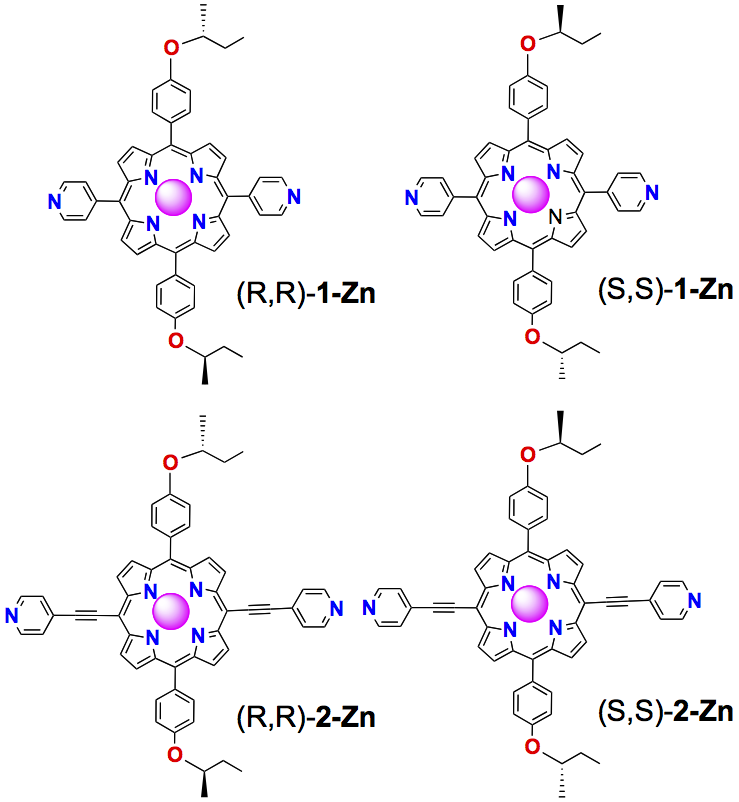 | 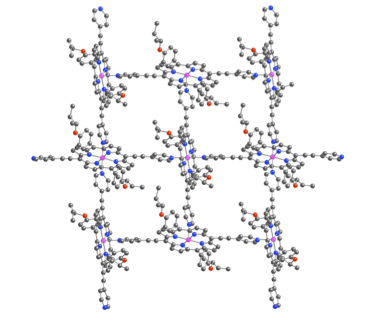 |  |
"Molecular tectonics: tuning dimensionality and topology of extended cyanocuprate networks by bisamidinium cation"
S. Ferlay, P. Dechambenoit, N. Kyritsakas, M. W. Hosseini Dalton Trans., 2013, 42, 11661-11671. (download .pdf)
Abstract:Upon combining KCu(CN)2 with six different symmetrical dicationic bisamidinium moieties possessing different shapes and geometries, seven new coordination networks of the cyanocuprate type displaying 1-, 2- and 3-D dimensionality have been obtained. The formation of networks results from the interconnection of Cu(I) centres by cyanide anions through different bridging modes. The organic dicationic tectons interact with the anionic networks by charge-assisted H-bonds and, depending on their geometric features, they play different structuring roles. In the case of the 1D cyanocuprate networks, the organic cation interconnects consecutive anionic chains increasing thus the overall dimensionality of the arrangement to 2D. For the 2D networks, either riveting or intercalation has been observed. For the riveting case, either the process takes place only between two consecutive sheets leading to a double layer type arrangement and thus without increase of dimensionality, or between consecutive 2D networks in an alternate fashion. In the latter case, the dimensionality of the overall architecture is increased to 3 as for the intercalated case. For the 3D architectures, the dicationic moieties are located within the generated channels.

"Ni(II) dipyrrin complexes bearing peripheral pyridyl or imidazolyl groups self-assemble into 2- and 3-D coordination polymers"
A. Béziau, S. A. Baudron, G. Rogez, M. W. Hosseini CrystEngComm, 2013, 15, 5980-5985. (download .pdf)
Abstract:While the numerous reported Ni(II) dipyrrin complexes are discrete species, derivatives bearing peripheral pyridyl or imidazolyl groups self-assemble into coordination networks. As reported with Cd(II) salts, reaction of the dipyrrin ligand functionalized with a 4-pyridyl moiety with Ni(OAc)2 affords a 2D coordination polymer in which the Ni(II) cation, in an octahedral environment, is bound to two dipyrrinato chelates and two pyridyl groups, in cis arrangement, belonging to neighbouring complexes. In the crystal, the layers are homochiral with a consecutive DLDL stacking. Interestingly, analogous reaction with the derivative bearing a peripheral phenyl-4-pyridyl unit forms a similar 2D organization, yet expanded owing to the presence of the phenyl spacer. In this case, the formation of homochiral sheets is also observed however with a single enantiomer of the complex in the crystal. Furthermore, whereas a distorted 2D coordination polymer is obtained with the novel dipyrrin ligand appended with a phenyl-3-pyridyl group, a 3D coordination polymer is formed with the slightly more flexible derivative bearing an imidazolyl moiety.

"Molecular Tectonics: Control of the Dimensionality in Tetramercaptothiacalixarenes based Coordination Networks"
A. Ovsyannikov, S. Ferlay, S. E. Solovieva, I. S. Antipin, A. I. Konovalov, N. Kyritsakas, M. W. Hosseini Inorg. Chem., 2013, 52, 6776-6778. (download .pdf)
Abstract:
Combinations of tetramercaptotetrathiacalix[4]arene pyridyl-appended positional isomers with HgCl2 lead to the formation of neutral coordination networks with their dimensionality imposed by the position of the N atom on the pyridyl group.
 |  |  |
"A platinum turnstile with a palladium lock "
N. Zigon, A. Guenet, E. Graf, N. Kyritsakas, M. W. Hosseini Dalton Trans., 2013, 9740-9745. (download .pdf)
Abstract:
An organometallic molecular turnstile composed of a stator based on an a,w-diphosphine bearing, in a symmetric fashion, the 2,6-pyridyl diamide moiety as a central tridentate chelating unit and a rotor composed of Pt(II) equipped with two pyridyl groups in trans configuration was designed. The switching between its open and closed states using Pd(II) was investigated both in solution and in the solid state.
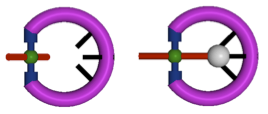 |  | 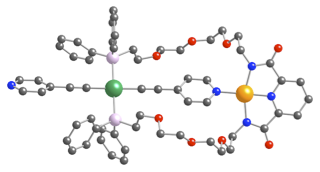 |
"Molecular tectonics: p-H-thiacalix[4]arene pyridyl appended positional isomers as tectons for the formation of 1D and 2D mercury coordination networks "
A. Ovsyannikov, S. Ferlay, S. E. Solovieva, I. S. Antipin, A. I. Konovalov, N. Kyritsakas, and Mir Wais Hosseini Dalton Trans., 2013, 9946-9953 (download .pdf).
Abstract:
Three p-H-thiacalix[4]arene pyridyl appended coordinating tectons (2-4) in 1,3-alternate conformation have been prepared and structurally characterised in the solid state. These compounds are positional isomers differing only by the position of the nitrogen atom on the pyridyl ring. Their combinations with HgCl2 lead to the formation of 1- and 2-D neutral mercury coordination networks. Whereas for tecton 2 (ortho isomer) a 2D architecture resulting from the bridging of consecutive tectons by the mononuclear HgCl2 unit is obtained, for tecton 3 (meta isomer) again a 2D networks is formed. However, in that case, the interconnection of consecutive organic tectons 3 takes place through a binuclear Hg2Cl4 species. Finally, in the case of tecton 4 (para position), a 1D ribbon type double chain arrangement resulting from the bridging of consecutive tectons by trinuclear Hg3Cl6 units followed by the interconnection of two chains through the fusion of the trinuclear centres into a hexanuclear nodes is observed.
 |  | 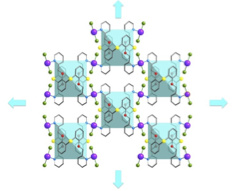 |
"Luminescent Coordination Polymers Based on Self-Assembled Cadmium Dipyrrin Complexes"
A. Béziau, S. A. Baudron, A. Guenet, M. W. Hosseini Chem. Eur. J., 2013, 19, 3215-3223. (download .pdf).
Abstract:
A series of novel Cd(II) complexes based on α,β-unsubstituted dipyrrin ligands (dpm) has been prepared and characterized both in solution and in the solid state. These compounds are of the Cd(dpm)2 type with the coordination sphere of the metal centre occupied by two dpm chelates. Interestingly, unlike what has been reported for the Zn(II) analogues, in the presence of a pyridyl- or imidazolyl-appended dpm, the coordination number of the Cd(II) cation increases up to six leading to an octahedral coordination sphere. As a consequence, the formation of 1-, 2- and 3-D coordination polymers by self-assembly is observed. Photophysical investigations of the discrete complexes and self-assembled networks demonstrated that both types of compounds are luminescent in the solid state.
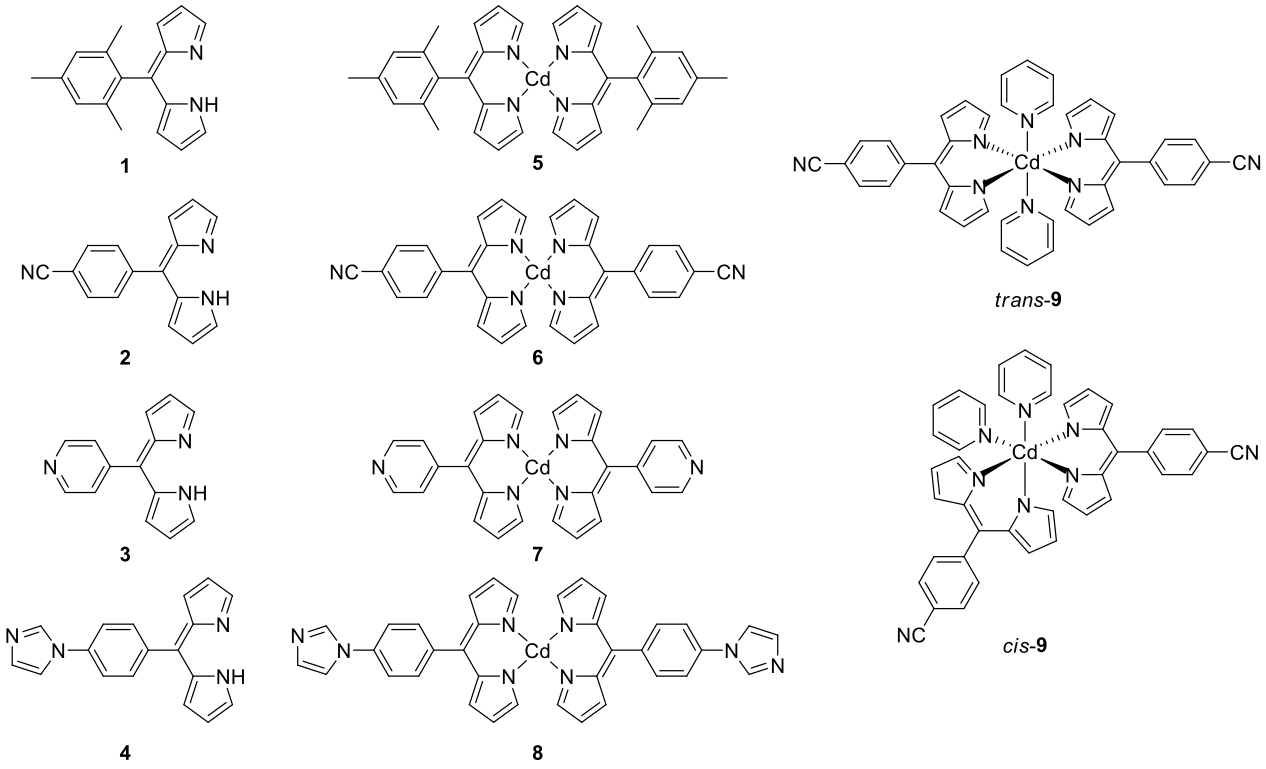 | 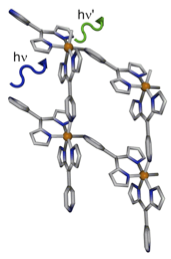 |  |
"Molecular tectonics:homochiral 3D Cuboid coordination networks based on enantiomerically pure organic tectons and ZnSiF6 "
Patrick Larpent, Aziz Jouaiti, Nathalie Kyritsakas and Mir Wais Hosseini Chem. Comm., 2013, 49, 4468-4470. (download .pdf).
Abstract:
Upon combining enantiomerically pure bis-monodentate organic tectons with ZnSiF6, homochiral 3D cuboid architectures displaying chiral channels are formed.
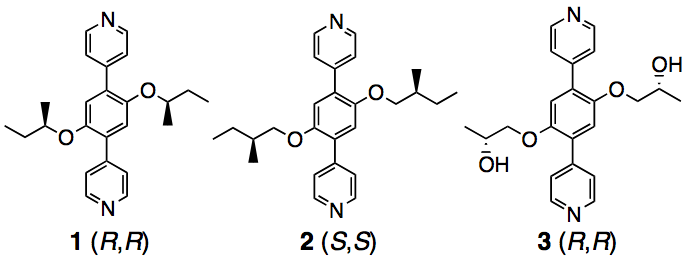 |  |
|
"A Platinum based organometallic turnstile"
Nicolas Zigon, Aurélie Guenet, Ernest Graf, and Mir Wais Hosseini, Chem. Comm., 2013, 49, 3637-3639. (download .pdf).
Abstract:
The synthesis of an organometallic turnstile based on a Pt(II) centre as a hinge was achieved. Its dynamic behaviour in solution was investigated by 1D and 2D NMR techniques. Using Ag(I) cation as an effector, the switching between its open and closed states in solution was demonstrated.
 |
|
"The odd association of a C3h trisamidinium cation and tosylate anion with a series of linear oxalate-bridged trinuclear heterometallic complexes"
Catalin Maxim, Emilio Pardo, Mir Wais Hosseini, Sylvie Ferlay and Cyrille Train, Dalton Trans., 2013, 42, 4704-4713. (download .pdf).
Abstract: A series of six isostructural heterometallic trinuclear oxalate-bridged complexes of formula (TDbenz)2(TsO)2[MII(H2O)2{(µ-ox)MIII(ox)2}2].6H2O.2CH3OH(TDbenz = 1,3,5-tris[2-(1,3-diazolinium)]benzene; TsO = 4-methylbenzenesulfonate; ox = oxalate; MIII = Fe, MII = Mn (1), Fe (2), Co (3); MIII = Cr, MII = Mn (4), Fe (5), Co (6)) have been synthesized from (NH4)3[MIII(ox)3].3H2O, the chloride salts of the divalent metal ions and the tosylate salt of 1,3,5-tris[2-(1,3-diazolinium)]benzene (trisamidinium). Whereas the crystal structures of compounds 2, 3, 4 and 5 have been investigated by single-crystal X-ray diffraction, the structures of 1 and 6 have been checked by X-ray powder diffraction. All six compounds are isostructural and crystallise in the Pī space group. The crystals are composed of discrete linear [MII(H2O)2{(µ-ox)MIII(ox)2}2]4- trinuclear bimetallic units, trisamidinium and tosylate ions and solvent molecules. The linear trinuclear unit is based on a central trans-diaquametal(II) entity connected to two [MIII(ox)3]3- (MIII = CrIII, FeIII) moieties through oxalate bridges.The divalent metal ions, surrounded by six oxygen atoms, adopt a distorted octahedral coordination geometry. The coordination sphere is composed of four oxygen atoms belonging to two oxalate ligands and two trans-coordinated water molecules. One of the oxalate ions is coordinated to the central metal centre whereas the other two oxalate ligands are non-bridging. In the crystal, intermolecular hydrogen bonds involving oxalate ligands, solvent molecules and the counter-ions form a complex 3D network. Variable-temperature magnetic susceptibility measurements indicate an antiferromagnetic interaction between the iron(III) and the metal(II) ions (J = -4.23, -6.73, -8.97 cm–1 for 1, 2 and 3 respectively) whereas this interaction is ferromagnetic when iron(III) is replaced by chromium(III) (J = +1.21, +2.20, +3.63 cm–1 for 4, 5 and 6 respectively). Moreover, the cobalt(II) derivatives exhibit high D values (D = 29.3 cm–1 for 3 and D = 27.4 cm–1 for 6).
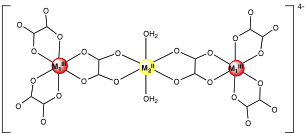 | 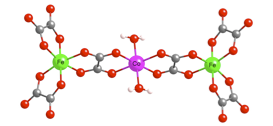 | 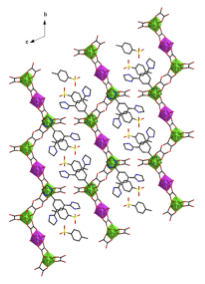 |
"Molecular tectonics: pyridyl containing thiacalix[4]arene based tectons for the generation of 2- and 3-D silver coordination networks "
A. Ovsyannikov, M. N. Lang, S. Ferlay, S. E. Solovieva, I. S. Antipin, A. I. Konovalov, N. Kyritsakas, M. W. Hosseini, Dalton Trans., 2013, 42, 116-126. (download .pdf).
Abstract: Three new organic tectons (2-4) based on the p-tert-butylthiacalix[4]arene backbone, blocked in the 1,3-alternate conformation, bearing four pyridyl coordinating moieties, have been synthesised and characterised in the solid state. The ligands are positional isomers and differ by the position of the N atom on the pyridyl unit (ortho for 2, meta for 3 and para for 4). Their combination with Ag+ cation leads, reproducibly, to the formation of 2- and 3-D infinite silver coordination networks. Independent of the nature of the anion, the combination of 2 offering four (N,S) type chelate with Ag+ cation affords an unprecedented diamond type 3D network. Both 3 and 4, behaving as tetrakis monodentate ligands, lead to the formation of 2-D architectures.
 | 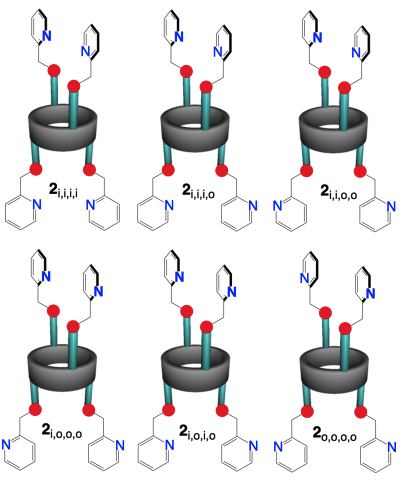 |  |
" Zinc- and palladium-porphyrin based turnstiles "
Thomas Lang, Ernest Graf, Nathalie Kyritsakas, Mir Wais Hosseini, New J. Chem., 2013, New J. Chem., 37, 112-118 . (download .pdf)
Abstract: The design, synthesis of two new Zn(II) and Pd(II) strapped-porphyrin based molecular turnstiles have been achieved. These molecules are based on a porphyrin backbone as a stator and a handle as a rotor. The junction between the two parts is ensured by covalent bonds using two opposite meso positions. Both compounds have been characterised in solution by NMR spectroscopy and in the solid state by X-ray diffraction on single crystal. The dynamic of the two systems have been investigated in solution by 1- and 2-D NMR techniques such as ROESY. The switching between the open and closed states is described. Whereas for the Pd(II) complex, the handle freely rotates around the stator, for the Zn(II) analogue owing to the presence of a water molecule bound to the zinc atom and hydrogen bonded to the pyridyl moiety of the rotor, the rotation is blocked. The unlocking of the rotational movement was achieved using an external agent, mainly dimethylaminopyridine as a strong coordinating ligand.
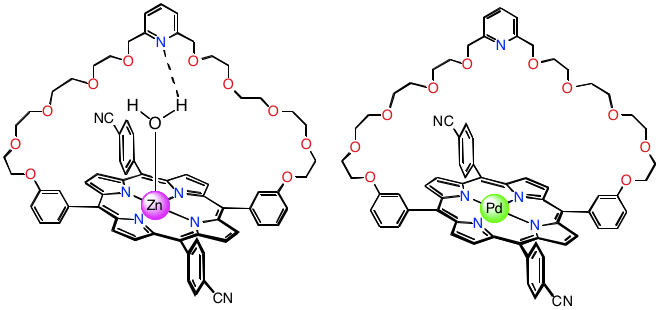 |  |  |
" From discrete tricyanovinylene appended 7-azaindole copper(II) paddlewheel to an infinite 1D network : synthesis, crystal structure and magnetic properties "
Dmitry Pogozhev, Stéphane A. Baudron, Guillaume Rogez and Mir Wais Hosseini, Polyhedron., 2013, 52, 1329-1335. (download .pdf)
Abstract: A tricyanovinylene appended 7-azaindole derivative (TCVazaH) was synthesised and used as a ligand for the formation of paddlewheel type complexes ([(TCVaza)4Cu2], 1) upon reaction with CuX2 salts. The role played by the anion X- (NO3-, TfO- or Cl-) on the formation of the copper complexes was studied. Whereas for NO3- or TfO- anions, a discrete complex [(1)(DMF)2] was obtained, in the case of Cl-, a 1D infinite chain 2 ([(1)CuCl2(DMF)4]) was formed. The presence of the same paddlewheel core is the common feature between the discrete binuclear complex and the infinite 1D network. In both cases, the cis-(2,2) regioisomer of the binuclear unit is observed. While, in the discrete species, the axial positions of the Cu centres are occupied by DMF molecules, in the infinite chain, the DMF molecules are replaced by chloride anions leading thus to the formation of an anionic paddlewheel [(1)Cl2]2- unit. The bridging of the latter by [Cu(DMF)4]2+ cationic complexes generates the 1D chain. The study of the magnetic properties of [(1)(DMF)2] by magnetometry using a SQUID magnetometer revealed a strong antiferromagnetic coupling with J = -327(5) cm-1 between the two Cu(II) centres within the paddlewheel complex. For the infinite network 2, the magnetic coupling within a paddlewheel complex is too strong for any coupling with the bridging [Cu(DMF)4]2+to be observed.
 |  |
|





